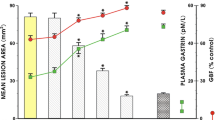Abstract
Systemic administration of capsaicin aggravates ethanol-induced injury of rat gastric mucosa. We evaluated the effect of subcutaneous administration of capsaicin on the gastric mucosa and on inflammatory mediators in saline- and ethanol-treated rats. Functional ablation of primary afferent C-fibers by capsaicin (total 100 mg/kg subcutaneous) tripled ethanol-induced damage. Pretreatment with ketotifen, a mast cell stabilizer (1 mg/kg) protected rat gastric mucosa from the amplified injury induced by capsaicin and ethanol. Tempol, a selective nontoxic cell-permeable nitroxide, completely prevented the amplified gastric ulceration induced by capsaicin and ethanol. This was accompanied by a significant decrease in leukotriene B4 and C4 generation. It is therefore suggested that mast cells and free radicals contribute to the amplified injury observed in rats pretreated with capsaicin and ethanol and that the pharmacological modulation of mast cell release and scavenging of free radicals may be of therapeutic efficacy in the prevention of gastric injury.
Similar content being viewed by others
References
Holzer P, Sametz P: Gastric mucosal protection against ulcerogenic factor in the rat mediated by capsaicin sensitive afferent neurons. Gastroenterology 91:975–981, 1986
Holzer P: Local effector functions of capsaicin-sensitive sensory nerve endings: Involvement of tachykinins, calcitonin gene related peptides and other neuropeptides. Neuroscience 24:739–768, 1988
Evangeliste S, Maggi CA, Meli A: Influence of peripherally administered peptides on ethanol induced gastric ulcer in the rat. Gen Pharm 18:647–649, 1987
Karmeli F, Eliakim R, Okon E, Rachmilewitz D: Gastric mucosal damage by ethanol is mediated by substance P and prevented by ketotifen, a mast cell stabilizer. Gastroenterology 100:1206–1216, 1991
Karmeli F, Eliakim R, Rachmilewitz D: The effect of calcitonin gene related peptides on ethanol induced gastric injury in rats. Gastroenterology 102:A94, 1992
Lambrecht N, Burchert M, Respondek M, Muller KM, Peskar BM: Role of calcitonin gene related peptide and nitric oxide in the gastroprotective effect of capsaicin in the rat. Gastroenterology 104:1371–1380, 1993
Stead RH, Tomioka M, Riddell RH, Bienenstock J: Substance P and/or calcitonin gene related peptides are present in subepithelial enteric nerves apposed to intestinal mucosal mast cells.In Inflammatory Bowel Disease: Current Status and Future Approach. RP MacDermott (ed). Amsterdam, Elsevier Scientific Publications, 1988, pp 43–48
Wallace JL, McKnight GW, Befus AD: Capsaicin-induced hyperemia in the stomach: Possible contribution of mast cells. Am J Physiol 263:G209-G214, 1992
Nordmann R, Ribiere C, Rouach H: Implication of free radical mechanisms in ethanol-induced cellular injury. Free Radic Biol Med 12:219–240, 1992
Pihan G, Regilo C, Szabo S: Free radicals and lipid peroxidation in ethanol- or capsaicin-induced gastric mucosal injury. Dig Dis Sci 32:1395–1401, 1987
Szelenyi I, Brune K: Possible role of oxygen free radicals in ethanol-induced gastric mucosal damage in rats. Dig Dis Sci 33:865–871, 1988
Kvietys PR, Twohig B, Danzell J, Specian RD: Ethanol-induced injury to rat gastric mucosa. Role of neutrophils and xanthine oxidase-derived radicals. Gastroenterology 98:909–920, 1990
Craps LP, Ney UM: Ketotifen: Current views on its mechanism of action and their therapeutic implications. Respiration 45:411–421, 1984
Hachisuka H, Nomura H, Sakamoto F, Mori O, Okubo K, Sasai Y: Effect of antianaphylactic agents on substance P induced histamine release from rat peritoneal mast cells. Arch Dermatol Res 280:158–162, 1988
Rachmilewitz D, Karmeli F, Okon E, Samuni A: Nitroxide stable radicals prevent gastric mucosal damage induced by ethanol or non-steroidal anti-inflammatory drugs. Gut 35:1181–1188, 1994
Szolcanyi J, Bartho L: Impaired defense mechanism to peptic ulcer in the capsaicin desensitized rat.In Advanced Physiological Sciences, Vol 15, Gastrointestinal Defense Mechanisms. GY Mozsic, O Hanninen, T Javor (eds). Oxford and Budapest, Pergamon Press and Akademiai Kiado, 1981, pp 39–51
Martling CR: Sensory nerves containing tachykinins and cGRP in the lower airways. Acta Physiol Scand Suppl 563:1–57, 1987
Ligumsky M, Karmeli F, Sharon P, Zor U, Cohen R, Rachmilewitz D: Enhanced thromboxane A2 and prostacyclin production by cultured rectal mucosa in ulcerative colitis and its inhibition by steroids and by sulfasalazine. Gastroenterology 81:444–449, 1981
Sharkey KA, Williams RG, Dockray GJ: Sensory substance P innervation of the stomach and pancreas. Demonstration of capsaicin sensitive neurons in the rat by combined immunohistochemistry and retrograde tracing. Gastroenterology 87:914–921, 1984
Holzer P, Lippe IT: Stimulation of afferent nerve endings by intragastric capsaicin protects against ethanol induced damage of gastric mucosa. Neuroscience 27:281–287, 1988
Peskar BM, Pallapies D, Dembinska-Kiec A, Kluge S, Peskar BA: Role of nitric oxide in gastroprotection. Digestion 49(suppl 1):8–9, 1991
Whittle BJR: Involvement of vasoactive and inflammatory mediators in gastric mucosal lesions. Digestion 49(suppl 1):11–12, 1991
Friedman ZY, Selinger Z, Karmeli F, Eliakim R, Rachmilewitz D: Enhanced colonic inositol phosphate generation in Crohn's disease and inhibition of its formation by ketotifen. Gastroenterology 102:A623, 1992
Mitchell JB, Samuni A, Krishna MC, DeGraff WG, Ahn MS, Samuni U, Russo A: Biologically active metal-independent superoxide dismutase mimics. Biochemistry 29:2802–2807, 1990
Gelvan D, Saltman P, Powell SR: Cardiac reperfusion damage prevented by a nitroxide free radical. Proc Natl Acad Sci USA 88:4680–4684, 1991
Hahn SM, Tochner Z, Krishna MC, Glass J, Wilson L, Samuni A, Sprague M, Venzon D, Glatstein E, Mitchell JB, Russo A: Tempol, a stable free radical, is a novel murine radiation protector. Cancer Res 52:1750–1753, 1992
Author information
Authors and Affiliations
Rights and permissions
About this article
Cite this article
Karmeli, F., Eliakim, R., Okon, E. et al. Ketotifen and nitroxides decrease capsaicin-augmented ethanol-induced gastric damage in rats. Digest Dis Sci 40, 1140–1146 (1995). https://doi.org/10.1007/BF02064212
Received:
Revised:
Accepted:
Issue Date:
DOI: https://doi.org/10.1007/BF02064212




